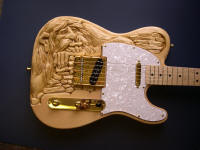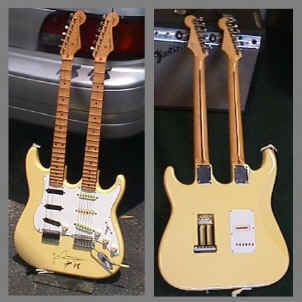 |
INTERESTING GUITARS Page 3 |
 |
INTERESTING GUITARS Page 3 |
| Page 1, Page 2 | |
|
|
LAWSUIT, YOU SAY? While this photo is not of a guitar per se, this may be interesting. Who remembers the New York Dolls? The guy with the V is Sylvain Sylvain. Note: This was the band in which the pre-Buster Poindexter David Johanssen was the lead singer. For those of you too young to remember, Ibanez used to be the Japanese company that made killer copies of Gibsons and Fenders -- and the Iceman, of course. This poster from the mid-1970's (probably 1975) shows some of the models they used to make. Any of them look familiar? You'll hear a lot of folklore about this lawsuit and that lawsuit. I just think Ibanez got tired of copying Gibson and Fender...click here for more info. Good thing, too, because their guitars in the 80's and 90's were great -- look for a sunburst double-cut Artist with a great top. I wanted to buy a Destroyer (an Ash Explorer clone) when I was in high school and my dad said it didn't look like a real guitar. Bad move. |
|
"TrollCaster" |
 |
|
Gibson Q100 Ryan B of Tennessee wanted to
know more about his Gibson Q4000 -- well, I have its cousin - a Q100.
|
|
|
Gibson Q4000 We got this email in October 2006:
It looks like the one on your site (from Ryan B.) with the 2 single coils and a humbucker with 2 knobs and 2 switches. Gibson won't get back to me about it for some reason, and I have not been able to find anything about it. Thanks for your help, and please let other owners know that they may contact me concerning these guitars. Andy We're still learning, too. Keep those emails coming in...we want to see all of those Qs! |
|
Yngwie Doubleneck Just when you thought it was safe to hit the Fender Japan website, this beast appears. Like the line from Godzilla - "What have we done to deserve such devastation?" - this guitar appears out of the depths to confuse/confound even the most rabid StratMaster. What you have here is, of course, a double-neck Yngwie Strat. What makes this one wild is that the neck on top sports nylon strings and a Mike Christian piezo bridge. It should be standard issue for Metal Gods! It would be cool to play while standing in a blanket of dry ice fog and the blue lights are shining down from behind. Dude!
|
 |
|
|
|
|
But wait....another Yngwie Doubleneck! Allegedly built by the Fender Custom Shop in 1990 for Mr. Malmsteen, this guitar is yet another ultimate shred machine. This is a 6/12 guitar, and it appears that the 12 string neck is not scalloped. Note the Yngwie signatures on the headstocks. That's fine...we still think it is killer. This would be a great project for a couple of Saga kits! ROCK! We love this guitar...it goes to 11! |
|
Flat-top Les Paul Custom Mr. Les Paul was the ultimate tinkerer, and his curiosity gave us some of the great inventions of the 20th Century! This photo, which can be seen in its entirety on page 6 of Tony Bacon and Paul Day's Gibson Les Paul book (ISBN: 0-87930-289-5), has always tweaked our curiosity, and we are looking for your collective takes on it. This photo was taken in Gibson's Kalamazoo, Michigan factory in 1955. Mr. Les Paul (shown on the left, holding the guitar) and Mr. Ted McCarty (right), president of Gibson, are seen examining a new Gibson Les Paul guitar. The guitar was reportedly a custom instrument made for Mr. Paul. Mr. John Huis, Mr. Carty's assistant in charge of production, is seen in the background wearing a dark suit. What is interesting about this Les Paul is that it has a flat top! It is not carved like all of the other Les Paul Customs we've ever seen. What happened to this guitar? Has anyone seen it? Let the search begin! |
|
|
|
|
|
|
|
|
|
Jump to
Gibson of today....Ever wonder how Gibson mother-of- pearl (MOP) inlays look
before they are painted-over and scraped? Well, here is the answer.
I bought these inlays from a guy in Nashville, and they really shocked me
when I saw them. I had examined a number of late-50's Les Pauls, and it was clear that the MOP was inlayed directly into the headstock veneer. There are some pretty wide differences in the old inlays (particularly with the dot over the "i"), but these photos show why all of the new ones are the same. The MOP is cut with a CNC router and is glued into an ebony "surround". The surround is glued into the headstock veneer, which is cut to size with a CNC router also. Why, you ask? Simple -- gluing the MOP inlay into the veneer is as easy as it gets, and doesn't require skilled labor! By the way -- examine your Historic Reissue. Chances are the MOP inlay is not historically correct at all. Most all I've seen have this stock MOP inlay that is sprayed with yellow-gold toner to make it look old. The top photo shows an MOP inlay glued into a very thin maple headstock veneer. The bottom photo shows the same veneer glued onto a heavily damaged Les Paul Standard I repaired. |
|
|
|
| Page 1, Page 2 | |